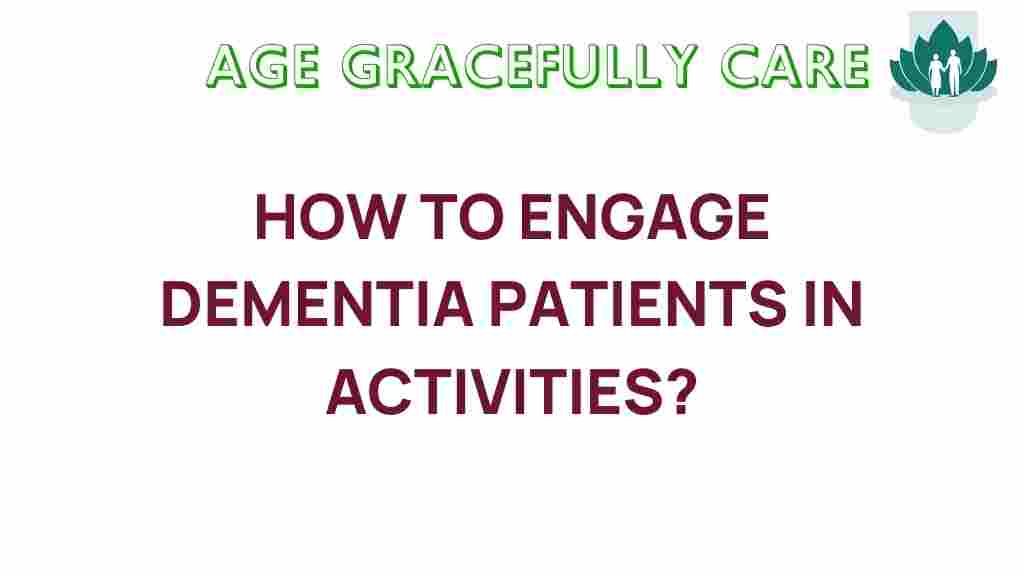Dementia Activities: Unlocking Joy Through Engaging Experiences
Dementia can be a challenging journey for both patients and caregivers. However, engaging in purposeful and enjoyable activities can significantly enhance the quality of life for individuals living with dementia. This article explores various dementia activities that focus on patient engagement, cognitive stimulation, and social interaction. By incorporating these therapeutic activities into elderly care, caregivers can foster joy and connection in their loved ones’ lives.
Understanding the Importance of Engagement
Engaging dementia patients in meaningful activities is crucial for several reasons:
- Cognitive Stimulation: Activities that challenge the mind can help slow cognitive decline.
- Emotional Well-being: Engaging activities can reduce feelings of isolation and depression.
- Social Interaction: Participating in group activities fosters connections with others.
- Physical Health: Many activities also promote physical movement, enhancing overall health.
Types of Dementia Activities
There are numerous types of activities that can be tailored to dementia patients. Below are some categories of dementia activities that can provide cognitive stimulation and joy:
1. Creative Activities
Creativity can flourish in dementia patients, even in advanced stages. Here are some engaging creative activities:
- Art Therapy: Encourage painting, drawing, or coloring. Use simple materials like watercolors or coloring books.
- Music Therapy: Play familiar songs, sing along, or even encourage playing instruments. Music can evoke emotions and memories.
- Crafting: Simple crafts like making greeting cards or seasonal decorations can be enjoyable.
2. Cognitive Activities
Activities that stimulate cognitive function can help maintain mental acuity. Consider these options:
- Puzzles: Offer jigsaw puzzles, crosswords, or Sudoku. Customize the difficulty based on the patient’s ability.
- Memory Games: Use cards or photos to play memory games that encourage recall and recognition.
- Storytelling: Invite patients to share stories from their past, or read short stories together to prompt discussion.
3. Physical Activities
Physical engagement is essential for health. Here are some activities that can be adapted for dementia patients:
- Chair Exercises: Simple chair exercises can improve mobility and strength without overwhelming patients.
- Walking Groups: Organize short walks in a safe environment to encourage social interaction and physical activity.
- Gardening: If possible, engage patients in simple gardening tasks, such as planting flowers or watering plants.
4. Social Activities
Social interaction is vital for emotional health. Here are some ideas:
- Group Games: Organize games like bingo or trivia that encourage participation and laughter.
- Memory Sharing Sessions: Create opportunities for patients to share memories and experiences in a group setting.
- Family Visits: Encourage regular visits from family members to help maintain connections.
Implementing Engaging Activities: A Step-by-Step Process
To effectively implement dementia activities, follow this structured approach:
Step 1: Assess Individual Needs
Understand the interests, abilities, and preferences of the dementia patient. Consider conducting an informal assessment through conversations or observing their reactions to different activities.
Step 2: Plan Activities
Select a variety of activities that cater to cognitive, social, and physical engagement. Aim for a balance that keeps the patient stimulated without overwhelming them.
Step 3: Create a Routine
Establish a daily or weekly routine that incorporates various activities. Consistency can provide structure and comfort for dementia patients.
Step 4: Involve Caregivers and Family
Encourage participation from caregivers and family members. Collaborative engagement can enhance the experience and foster deeper connections.
Step 5: Monitor and Adapt
Observe how the patient responds to different activities and be willing to adapt based on their mood and preferences. Flexibility is key in elderly care.
Troubleshooting Tips for Engagement
Engaging dementia patients can sometimes be challenging. Here are some tips for troubleshooting common issues:
- Resistance to Participation: If the patient resists an activity, try a different one or modify the approach to make it more appealing.
- Frustration with Tasks: Simplify tasks or break them down into smaller steps to reduce frustration.
- Short Attention Span: Keep activities brief and allow for breaks to accommodate shorter attention spans.
- Communication Barriers: Use non-verbal cues, visual aids, or gestures to enhance understanding and participation.
Conclusion: Embracing Joy in Dementia Care
By engaging dementia patients in meaningful activities, caregivers can unlock moments of joy and connection. Whether through creative, cognitive, physical, or social activities, the goal is to enrich the lives of those living with dementia. Remember, the key is to tailor activities to the individual’s interests and abilities, ensuring that every moment spent together is filled with purpose and happiness.
For more resources on dementia care and activities, consider visiting this helpful resource. Additionally, you can explore community programs that offer various therapeutic activities for dementia patients.
Implementing these dementia activities not only benefits the patients but also aids caregivers in fostering a nurturing and joyful environment. With love, patience, and creativity, we can make a significant difference in the lives of those affected by dementia.
This article is in the category Care and created by AgeGracefullyCare Team
